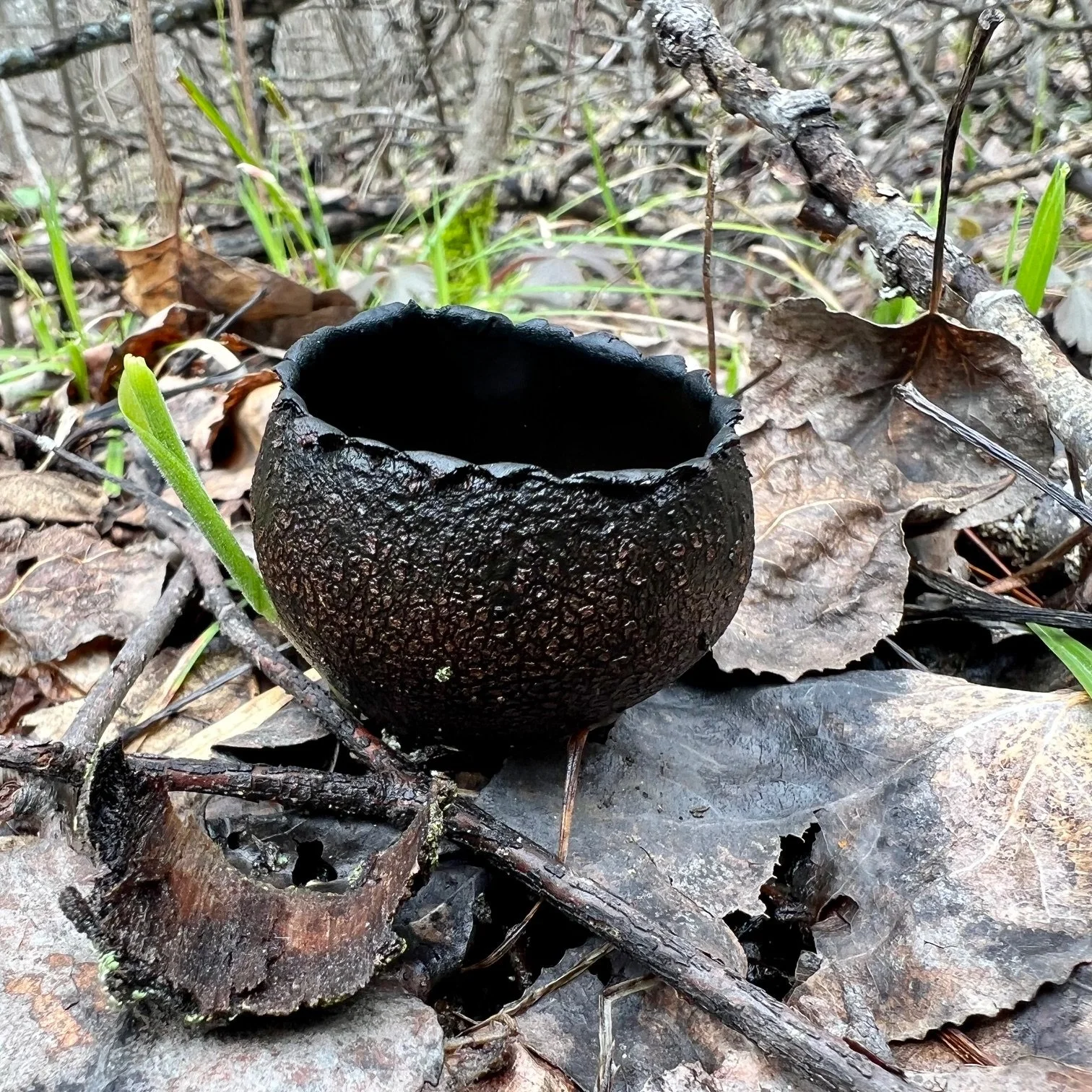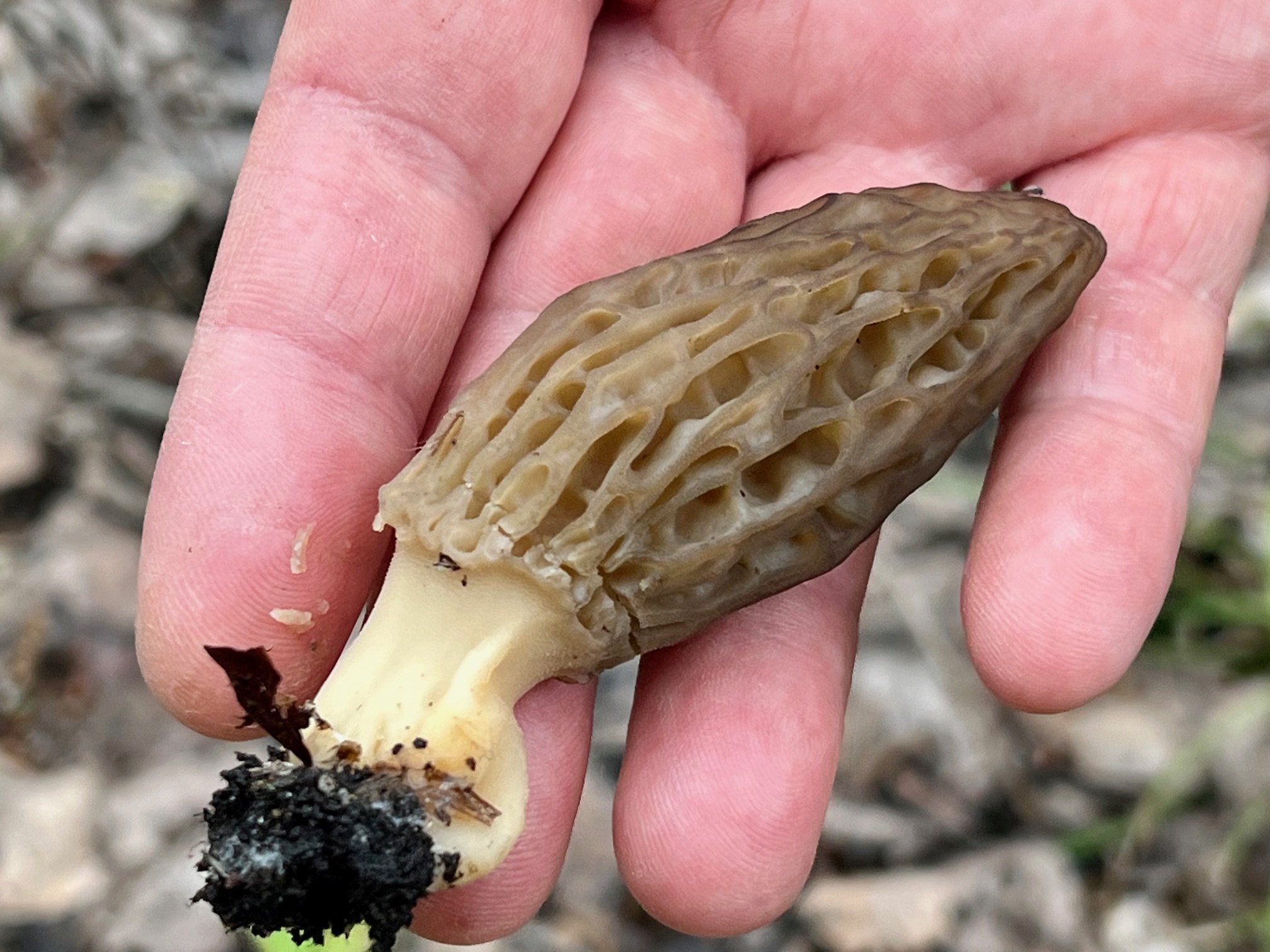We’re tickled to be sharing an excerpt from the lastest book from the original “fun-gal”, mushroom hunter and author extraordinaire, Ariel Gordon.
Both personal and entertaining, Fungal: Foraging in the Urban Forest is the highly anticipated second book of a trilogy and shows Gordon at her best: interweaving the personal with the easily-overlooked natural world around her, and passing on her contagious delight for the world at—and under—our feet.
In a diverse range of essays, Gordon takes us deep into the fungal world, exploring mushrooms both edible and not, found and foraged, and the myriad ways in which mushrooms and trees make up our ecosystem and are in fact a reflection of the way we build our personal communities and connections.
Fungal: Foraging in the Urban Forest by Ariel Gordon, published by Wolsak & Wynn. Preorder here.
Excerpt from “Morel Hunter”
in Fungal: Foraging in the Urban Forest
by Ariel Gordon
It was May 2022 when I dragged my partner Mike out of the house to go looking for morels. I guess you could call him my “morel support.” (Ahem.)
I have always wanted to find mushroom kindred spirits and the Winnipeg Mycological Society // Société mycologique de Winnipeg group on Facebook had them in every shape and size, from newbies dumping a hatful of random mushrooms to experts sharing a trunk full of morels. The group currently has 4,800 members and is led by Alexandre Brassard, the Dean of Arts and Science at the Université de Saint-Boniface and a political scientist by training.
The threshold for membership is gloriously low: “Intrigued by mushrooms? This is a forum to learn more about them and to talk about the fungi of Manitoba and the Canadian Prairies. This Facebook page is the ideal place to discuss Prairie species and sites, to share foraging and cultivation tips, to support the correct identification of local mushrooms, and to share news about mycological events in Winnipeg.”
Serious mushrooming is often about research. What trees are the mushrooms you’re after in association with? What kind of soil/moisture level do they prefer? Do they flush the year after forest fires? Where were the most recent forest fires? What Crown land (or property owned by a friend) meet all of these criteria. I have done the bulk of my mushrooming in a few spots. I’ve become a specialist of mushrooms in aspen/oak parkland, but, more specifically, in Assiniboine Forest, a never-developed urban forest in the south end of Winnipeg. I’m not good at mushrooms in coniferous forests or even mixed deciduous forests.
Ariel in her element!
I’d only ever found a handful of morels, in in this one spot on the Harte Trail in Assiniboine Forest and then another handful in the Belair Forest. But the group had lots of people finding morels or talking about finding morels, with tips on where/when to find them.
People are secretive about their ‘spots’, the locations on crown land that produce the mushrooms they’re looking for in profusion, year over year. But enough people had let slip that poplar forests in SE Manitoba, and specifically in Sandilands Provincial Forest, were good sites.
So Mike and I got up early on a Saturday and drove out. Given that Sandilands is a big place, I did some searching and discovered that the Sandilands Ski Club had two parking lots, one of which was described as being hillier. So we headed towards that one, using the GPS tag from their website.
We parked and set out on one of their cleared ski trails, which had long since melted. And of course the trees were wrong: conifers and birches. We kept walking, scanning the horizon for white/grey trunks. One whole section was completely swamped with water, where we had to walk from shoal to shoal or just try to avoid the bigger pools.
Of course, that’s also where all the non-morel mushrooms where. Mike spotted devil’s urn (Urnula craterium), a black mushroom that’s the shape of a cauldron. I’d never seen it before, but people had been posting it to the WMS, alongside a similar looking species, witches’ cauldron (Sarcosoma globosum), which is brown instead of black. I spotted three types of jelly fungi, including blobs of yellow witches’ butter, a brown variety, and a black variety that completely covered sections of trunk on young trees. There were also mushrooms on stumps and downed trees.
Another pleasure, while walking through higher sandy areas, were all the prairie crocuses. One of my spring requirements is finding and photographing prairie crocuses while they’re blooming. Before two years ago, I hadn’t seen them very often, even though they’re the provincial flower. I think it’s because the areas I regularly walk in aren’t prime territory for them: like morels, they like sand. Previously, I’d go find them in Little Mountain Park, a city park that is mostly an off-leash dog park. I’d wait until a friend who took her dog there regularly posted about them. But we’d had good luck finding at least one prairie crocus the last two years and one was all I needed.
This year, I had heard that they were blooming, but I hadn’t had the chance to head to LMP yet. There were some blooming in the native prairie garden in the Wolseley Community Garden’s Vimy Ridge Garden, and I was there anyways, helping to shovel mulch into the beds, so I took a photo of them. But they were a placeholder for me until I could find something more wild. “Someone came and dug one of the crocuses out,” one of the garden organizers said, surveying the bed. She shrugged: that kind of activity was part of what happened in community gardens. And at least whoever it was hadn’t taken every plant. But prairie crocuses were everywhere in Sandilands, even by the side of the road. They became common, so I eventually only stopped for large clusters of them.
We trudged through the swamped area, skipped through the crocus area, and eventually found an area that was mostly poplars. We walked through that for twenty minutes before we found our first mushroom.
We found one, and then a handful, and then a bagful, moving slowly, trying to look sideways. We would often call out to each other: “There’s one by your foot. And another and oh, look, another.” I got out my mushroom knife, given to me at Xmas, and was using them to cut the stems, though they were delicate and often snapped between our fingers. I also used my knife to collect a handful of fiddleheads, the early coiled leaves of ostrich ferns, which were also coming up in that area.
I knew that these were early spring morels, sometimes also called false morels: Verpa bohemica. But verpas are in the Morchella family with the more standard M. americana, and so should be called true morels. I’d seen verpas on the WMS group. Unlike morels, which were empty inside, verpas had a cotton-candy like fuzz inside of their stems and caps. Also, they were much taller than morels, and the texture of the cap was different.
We also found two small black morels. All in all, we felt very successful, walking back to the car.
*
There is some debate in the broader community as to whether verpas are edible, but I decided to try them.
I found a recipe online for verpas in a shallot vermouth sauce, but was mostly reading for the cooking instructions: “To begin the preparation fill a bowl with lightly salted cold water. Add the verpa bohemica mushrooms and give a shake. After 15 minutes pour out the water and refill the bowl with more cold water. Do this 3 times. After the 3rd time, lay your morels out on some paper towel and pat dry.” I’d read elsewhere that they should be parboiled or even just boiled twice. But I elected to use this method: given how delicate they were, I was worried that they’d fall apart if they were boiled. Even the soaking process disconnected most of the caps from the stems. I spent two hours soaking and draining my mushrooms, which had already started to soften in the mesh bag I’d collected them in.
I made a soup with the caps and some of the stems, with store-bought pho-flavoured broth, with onions and garlic and cilantro. When it was done, Mike and I each had a spoonful, as is recommended with all new foods but specifically wild mushrooms, and also wild mushrooms that are sort of…questionable.
The next day, neither of us had any aches and pains that were out of the ordinary for middle-aged people. We should have been fine to have big bowls of soup, which had looked and smelled delicious. Part of the reason we didn’t was that we had several meals out of the house in the days following and that our fridge was full of other options, but part of it was fear. The soup was in the bottom of the fridge, waiting. And food waste was one of my least favourite things. Was I going to let my fear win? Or was I going to wait until it went bad and throw it out? Finally, two days later, I reheated a bowl, adding some shredded pork that had been cooked carnitas style. And it was delicious. Mushroomy but not overly so. It was meaty and not just because I’d added the pork. My soups are not always great: I’m much better at making meatballs and stirfries for some reason. But this was probably the best soup I’d ever made.
I made a point of telling Mike how good it was. But he said he wasn’t sure if it was worth it, given the potential side effects. I experienced no side effects. So the next day, I had another bowl. I felt sustained by the soup, by the idea that I’d collected the mushrooms and carefully prepared them, but also because I’d overcome my fear. There’s one bowlful left. Mike still hasn’t had any, but he’s not as passionate about mushrooms as I am. And I have to respect his wariness.
But if the pandemic has taught me anything, it’s that we’re always assuming risk.
More About Ariel:
Ariel Gordon (she/her) is a Winnipeg/Treaty 1 territory-based writer, editor, and enthusiast. She is the ringleader of Writes of Spring, a National Poetry Month project with the Winnipeg International Writers Festival that appears in the Winnipeg Free Press. Gordon’s essay “Red River Mudlark” was 2nd place winner of the 2022 Kloppenberg Hybrid Grain Contest in Grain Magazine and other work appeared recently in FreeFall, Columba Poetry, Canthius, and Canadian Notes & Queries. Gordon's fourth collection of poetry, Siteseeing: Writing nature & climate across the prairies, was written in collaboration with Saskatchewan poet Brenda Schmidt and appeared in fall 2023.
--






